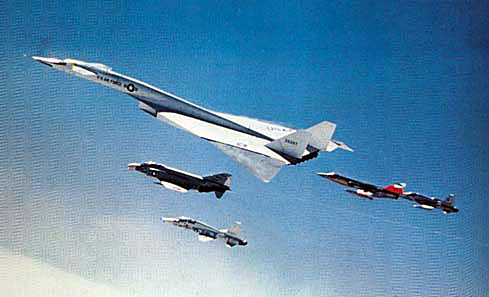
Forty-eight years ago this month, XB-70A Valkyrie Air Vehicle No. 2 (62-0207) took-off from Edwards Air Force Base, California for the final time.
The crew for this flight included aircraft commander and North American test pilot Alvin S. White and right-seater USAF Major Carl S. Cross. White would be making flight No. 67 in the XB-70A while Cross was making his first. For both men, this would be their final XB-70A flight.
In the past several months, Air Vehicle No. 2 had set speed (Mach 3.08) and altitude (74,000 feet) records for the type. But on this fateful Wednesday, 08 June 1966, the mission was a simple one; some run-of-the-mill flight research test points and a multi-aircraft formation photo shoot.
The General Electric Company, manufacturer of the massive XB-70A’s YJ93-GE-3 turbojets, had received permission from Edwards USAF officials to photograph the XB-70A in close formation with a quartet of other aircraft powered by GE engines. The resulting photos were intended to be used for publicity.
The formation, consisting of the XB-70A, a T-38A (59-1601), an F-4B (BuNo 150993), an F-104N (N813NA), and an F-5A (59-4898), was in position at 25,000 feet by 0845. The photographers for this event, flying in a GE-powered Gates Learjet (N175FS) stationed about 600 feet to the left and slightly aft of the multi-ship formation, began taking photos.
The photo session was planned to last 30 minutes, but went 10 minutes longer to 0925. Then at 0926, just as the formation aircraft were starting to leave the scene, the frantic cry of Midair! Midair Midair! came over the communications network.
Somehow, the NASA F-104N, piloted by NASA Chief Test Pilot Joe Walker, had collided with the right wing-tip of the XB-70A. Walker’s out-of-control F-104 then rolled inverted to the left and sheared-off the XB-70A’s twin vertical tails. The F-104N fuselage was severed just behind the cockpit and Walker was killed instantly in the process.
Curiously, the XB-70A continued on in steady, level flight for about 16 seconds despite the loss of its primary directional stability lifting surfaces. Then, as White attempted to control a roll transient, the XB-70A rapidly departed controlled flight.
As the doomed aircraft torturously pitched, yawed and rolled, its left wing structurally failed and fuel spewed furiously from its fuel tanks. White was somehow able to eject and survive. Cross never left the aircraft and rode it down to impact just north of Barstow, California.
A mishap investigation followed and (as always) blame was assigned. However, none of that changed the facts that on this, the Blackest Day at Edwards, American aviation lost two of its best men and aircraft in a flight mishap that never should have happened.


Comments
I just discovered your most interesting website.
Keep up the good work!
Steve Pace
Aviation History Writer/Historian
Tacoma, WA
Share this post: